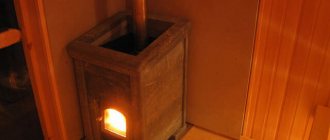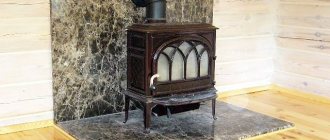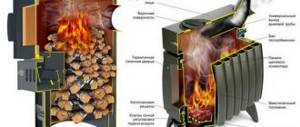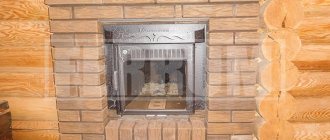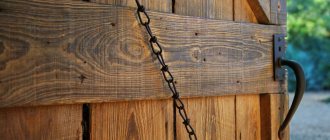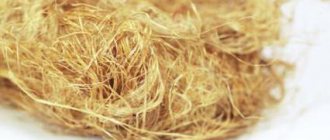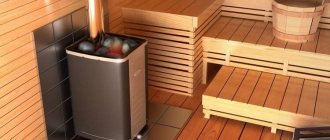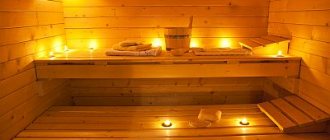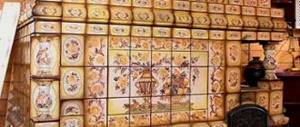The bathhouse is an integral part of the Russian tradition of healing the body and spirit, an unchangeable building on a country site that many people want to own.
The issue of decorating the main structural element is discussed at the design stage. The lining of a sauna stove plays not only an aesthetic role, but also a protective one. Often, bathhouse owners don’t bother and use simple plaster, which cracks over time, and the cracks are covered up from time to time.
The modern market is pleased with the abundance of various materials for lining a bathhouse stove, which are endowed with excellent performance characteristics. The most popular among them are: metal, wood, brick, tile, stone.
Metal sauna stove
This is the simplest and most traditional option for building a stove in a bathhouse.
The design has a number of advantages that make it popular:
- ease of installation;
- ease of use;
- heating in a short period of time;
- good traction;
- high efficiency;
- a budget option;
- economy in fuel consumption.
In order for the design to work properly, it is first prepared for operation and the initial characteristics are improved. We are talking about covering the frame with natural stone or brick. Considering the high cost of these materials, not everyone can afford to build a stove from them. And for cladding you will need much less of the same brick, so this option is quite acceptable for those who want to save money.
You can’t do without lining an iron stove in a bathhouse for several reasons:
- the metal quickly heats up, so being in the room becomes unbearable;
- rapid heating is replaced by rapid cooling. To maintain a certain temperature, you will have to constantly add firewood;
- the cladding will help optimize the heating process and maintain a comfortable temperature in the bathhouse, air humidity will be maintained at an optimal level;
- finishing materials will provide protection against burns that may occur if you accidentally touch the hot surface of a metal stove.
Reasons to line the stove in a bathhouse with bricks
Metal sauna stoves lined with brick
The decision must be made carefully, so we will name the reasons why an iron stove is lined with bricks in a bathhouse.
Unfortunately, the metal stove itself is a source of not only rapid heat, but also hard infrared radiation, which burns the skin from a distance, without contact with the object . In addition, a rapid increase in temperature in the bathhouse leads to dry air , and this is a big obstacle to creating the correct bathhouse microclimate. The third significant reason is that the metal not only heats up quickly, but also cools down quickly, and in a bathhouse this leads to excessive consumption of firewood and unnecessary movements.
Brick is an artificial stone , and therefore it takes longer to heat up than metal and gives off heat much longer. to eliminate the main disadvantages of a metal stove relatively cheaply (compared to natural stone) : make the radiation softer, warm up longer, but without drying out the air, increase the efficiency of the stove by retaining heat from wood burned in the stove longer.
Stone sauna stove lining
The choice of finishing materials, as well as their quantity, depends on the quality performance of the stove in the bathhouse. It goes without saying that the financial side of the issue plays an important role, but the first place should be given to the performance of the structure, taking into account the fact that the structure is not temporary.
A sauna stove must have the following characteristics:
resistance to high temperatures;- high thermal conductivity;
- resistance to mechanical loads;
- strength and reliability;
- aesthetics;
- moisture resistance.
The following materials are suitable for finishing the stove: brick, tile, tiles, natural stone, wood. Each material has its own advantages and disadvantages.
Useful video
The first video will be useful for those who have never laid a brick themselves.
A video about how to get a Russian bathhouse by lining a metal stove with brick yourself and cheaply
In the following video, Teklar demonstrates the principle and procedure for lining its own furnace with an external firebox.
*** Well, now you are fully armed with the knowledge of how, why and what you can line an iron stove in a bathhouse with. We can only wish you success and easy steam!
Cladding the stove in the bathhouse with bricks
The brick has an aesthetic appearance and is suitable for both the construction of stoves and cladding. For laying on the surface there is no need to install a reinforcing mesh. It is important to take into account that the material is quite heavy and puts a significant load on the foundation. It is this nuance that must be taken into account at the stage of creating the drawing.
Advice.
To create a decorative finish for a sauna stove, facing bricks are used.
Decorative brick for cladding a stove in a bathhouse can transform the stove beyond recognition, making it a kind of work of art. This material is not inferior in beauty to marble or granite. In order to line a metal furnace, fine dry sand is poured between its walls and brick to protect against metal deformation, which inevitably occurs when exposed to high temperatures. In addition, the layer facilitates the transfer of heat inside the steam room.
Step-by-step instruction
Work on the portal should be carried out in accordance with the preliminary construction plan and previously carried out calculations. For example, a masonry of 45–50 bricks requires the consumption of 20 liters of working solution. The stages of work are as follows:
- To prepare the solution yourself, mix clay, sand and water in a ratio of 4:2:1.
- At the first stage, the base is laid. The bottom rows of the brick structure should be as smooth and neat as possible, which will allow you to get a beautiful and durable furnace portal. The distance from the walls to the masonry can vary between 5–15 cm. The side parts of the portal are erected with mandatory suture bandaging after marking the location for the door. All excess cement mixture is removed using a trowel, and the rows are leveled in height with a hammer. The free joint space is used for subsequent grouting.
- The connection between the combustible walls of the room and the brickwork should not be made directly, so a layer of so-called refractory must be laid between them. Most often, modern but quite affordable materials are used for this purpose, including special mineral wool without any organic fillers, as well as special basalt cardboard. The same rule applies when arranging the space between the brick and the fuel channel.
- At the final stage of creating the portal, individual decorative finishing is performed, which is the design completion of the project. On the front side of the stove with a firebox and wood burner, a variety of shapes can be laid out or special linings made of refractory materials can be mounted. A worthy alternative would be beautiful carved or solid platbands, which very effectively hide all the cracks.
A brick U-shaped structure, called a portal, frames a sauna stove with an external firebox. Such a self-made device not only has a practical purpose, but also plays the role of decoration.
Finishing a sauna stove with tiles
Tiles are a versatile material, often used for different purposes. Its popularity is explained by its affordable cost and excellent performance characteristics. The disadvantage of ceramic tiles for lining a sauna stove is the limitation of the heating temperature. The elements are not equipped with locks for connection, so the material is deformed under the influence of high temperature. Experts do not recommend using ceramics for lining sauna stoves, but for fireplaces this is a completely suitable option.
Clinker tiles are ideal for finishing a sauna stove. A variety of textures and colors allows you to choose the best option for the steam room. The material is produced with imitation of various types of cladding: brick, tiles, wood, marble, granite. Clinker tiles have an increased level of wear resistance, strength and durability.
Note.
The outer coating of clinker can be glossy or matte.
To create an original and affordable finish for a sauna stove, a combination of ceramic tiles and clinker is used. In order for the material to be securely fixed to the surface of the stove, a high-quality adhesive composition with a high level of fire resistance is selected. This is something you shouldn’t skimp on, otherwise you’ll have to constantly replace the fallen tiles. The installation process is not particularly complicated; bathhouse owners can do it themselves if they wish.
Do-it-yourself tiles for lining a stove in a bathhouse
Stove makers have been looking for a long time for a suitable replacement for ceramic tiles, one that can withstand high temperatures and not deform. The task became easier with the advent of tiles. In other words, this is an ordinary tile made of clay with high heat resistance. The elements have a three-dimensional shape, the reverse side is equipped with protrusions called rumps. With their help, the tiles are combined with each other and form a continuous masonry.
The tiles are laid at the same time as the construction of the stove or fireplace. This allows you to strengthen the load-bearing wall of the furnace. To connect the structure to the main masonry, wire tendrils are used, which are placed in the seams between the bricks. The tiles are connected with so-called steel brackets and secured with cement mortar.
The variety of colors, patterns and textures of tiles is surprising. With such variety, you can choose any material and make your sauna stove unique.
Stone for facing a sauna stove
Natural or artificial stone is an excellent material for finishing a stove in a bathhouse. Natural material is highly valued due to its unique characteristics, including strength and durability. Imitation of natural stone is a modern, inexpensive finishing material that is almost in no way inferior to the previous one, meets the requirements of stove operation, withstands high temperatures and transfers heat.
Stoves lined with stone look breathtaking and cause admiration. When heated, natural stone releases heat and energy, and has a beneficial effect on the human body.
Important!
The adhesive composition for fixing the stone must be heat-resistant.
Natural stone for cladding a stove in a bathhouse:
- marble;
- slate;
- basalt;
- sandstone;
- soapstone;
- granite.
Artificial stone is preferred when the task is to reduce the budget for building a stove in a bathhouse. Considering the strength and reliability indicators that modern materials are endowed with, this option is considered one of the best. In addition, natural stone has a lot of weight, so a solid foundation is built under the bathhouse.
Stone
Decorative stone will fit well into a modern interior. Finishing the stove in the bathhouse with decorative stone will give it a finished look and will serve as an additional heat accumulator.
Kinds
The stone for cladding a sauna stove can be natural or artificial. Both types can be used when lining a sauna stove with stone.
- Natural stone - serpentinite, jadeite - has been used since ancient times when deciding how to decorate a stove in a bathhouse. It is very durable and holds the temperature well in the steam room.
- Artificial stone is, in fact, the same tile that repeats the pattern of natural stone in a steam room. The main advantage of this material is its low weight, which allows you to line the stove without an additional foundation. Artificial stone is cheaper. Therefore, it is becoming increasingly popular in the steam room.
Instructions
Finishing a sauna stove with stone is done in the same way as tiling. The glue should be applied evenly to the surface of the stone and to the wall. The thickness of the layer is 1-2 cm. If, as a result of cladding, a certain pattern should be obtained, you first need to make markings, number the necessary stones and only then proceed to cladding.
Examples of stove finishing with stone in the photo:
Photo 1
Photo 2
Photo 3
Photo 4
Wooden lining of a sauna stove
Wood is used in various fields of construction. The material is suitable not only as fuel for the stove, but also for beautiful decoration. Wood is strong and light at the same time, so it does not have a significant impact on the base of the bathhouse. When choosing wood as a decor, do not forget that the material does not have high thermal conductivity, so turning your idea into reality should be approached carefully. Wood is best suited for creating accents, finishing the floor, ceiling, corners of the steam room or bed.
Many people know about the low level of fire resistance of wood; therefore, the material is not recommended for use near an open fire source. Wood trims remote areas of the room, having previously treated the element with fire retardants.
